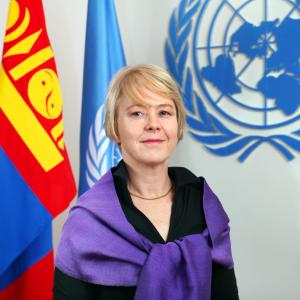Colleagues, ladies and gentlemen
Thank you for joining us for this important event on Asia Pacific’s food security.
Across the world, more people are going hungry today than in recent years. The recently released global report on food security shows the number of malnourished people has climbed back to 821 million – a number we haven’t seen in a decade. 60 percent of them live in Asia and the Pacific.
Shortly, we will be introducing the findings of a regional report on food security and nutrition – published jointly by FAO, UNICEF, WHO and WFP. And I must be honest: it presents a worrying picture.
After years of gains fighting hunger and malnutrition in this region, we now find ourselves at a virtual standstill. Mongolia has progressed on some indicators of hunger and malnutrition, but stalled in others.
So, what happened? Malnourishment is converging: on the one hand- absolute hunger; and on the other - an explosion in obesity. Paradoxically, while malnutrition remains high in Asia, the region is also experiencing the fastest rise in childhood obesity.
The report looks at what drives malnutrition. One thing I wish to highlight here is how the increasing frequency of climate-related events is shaking both economies and rural livelihoods in this region.
If we can’t control the weather, we must do more to safeguard our food chains. We must adapt agriculture and food production to be more resilient to changing weather and temperature patterns such as increasing droughts, typhoons and other events. We must also implement policies to address climate risks.
Likewise, much more needs to be done to ensure access to safe water, improvements to hygiene and sanitation. These are critical to ending malnutrition and hunger.
We cannot – and must not – allow the current stagnation in the fight against hunger and malnutrition to continue. Our future depends on the actions we take today. We have pledged – and governments have pledged – to end all forms of malnutrition by 2030. This is key to achieving the Sustainable Development Goals to end all poverty, narrow inequality and safeguard our planet.
The good news is, we have the tools and methods to end hunger by 2030. We can indeed still met that target. But it will take political will, major investments and broad based collaboration across sectors – within and between government ministries and policy makers.
It also means working more closely with those who know hunger and malnutrition first hand: small-scale farmers, herder and others. I’m also talking about rural women, who have the potential to feed a hungry region, but are too often undervalued. Their voices must be heard, as they are often the most vulnerable to hunger, and the most powerful change agents to end it.
We need pro-poor investments in sustainable agriculture, a greater emphasis on rural development, childhood and maternal nutrition, social protection and a range of other responses to growing urban populations. But the public sector cannot do it alone. We estimate that two thirds of the funds and technology needed to meet the SDGs globally have to come from companies. This presents businesses with opportunities to open new markets and seize the future, while making an invaluable contribution to humankind.
Hunger and malnutrition are not caused by a lack of food. They are caused by a shortage of compassion, deficits in choices and collective complacency.
My friends and colleagues: We have the knowledge. We have the solutions. What we need is action.
The fact that our four UN agencies in this region are uniting for the first time to report on food security and nutrition, signals the urgency of this fight. I hope this report and today’s event foster a more informed dialogue, and coordinated efforts by all partners, towards an Asia Pacific that is healthy – and free from hunger, for good.
Thank you.




